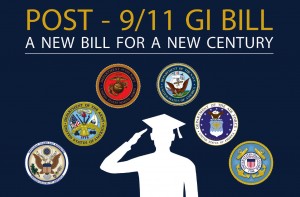
GI Bill Facts
 What is Today’s GI Bill?
What is Today’s GI Bill?
- The Post-9/11 GI Bill is the most robust education benefits program since the original GI Bill of Rights signed in 1944.
- The Bill enhances and expands the educational benefits available to service members and veterans who served on active duty following September 11, 2001.
- The GI Bill’s benefits include tuition payments made directly to schools, a monthly housing allowance, an annual stipend for books and school supplies, as well as other benefits.
- The Bill grants up to 36 months of higher education aid, based on service and enrollment status.
- It also authorizes active duty service members to transfer their education benefits to immediate family members.
What Exactly Does the New GI Bill Provide?
- The Post-9/11 GI Bil provides funding to service members and veterans pursuing undergraduate and graduate degrees, tutorial assistance, licensing and certification programs, and distance learning.
- Approved training under the Post-9/11 GI Bill includes graduate and undergraduate degrees, vocational/technical training, on-the-job training, flight training, correspondence training, licensing and national testing programs, and tutorial assistance. All training programs must be approved for GI Bill benefits.
Who’s Eligible for Today’s GI Bill?
- The Post-9/11 GI Bill provides financial support for education and housing to individuals with at least 90 days of aggregate active duty service on or after September 11, 2001, or individuals with at least 30 continuous days of active duty who have been seperated as a result of a service connected disability.
- Active duty Army, Navy, Air Force and Marines may use their GI Bill benefits, as may service members who are training overseas.
- Because the Post-9/11 GI Bill counts total active duty service, members of the National Guard and Reserves may add up multiple deployments to count toward the benefit, which can provide an increased amount.
What are You Entitled To?
- Service members and veterans are entitled to GI Bill benefits based on the length of their active duty service completed following September 11, 2001.
| Active Duty Completed after September 11, 2021 | Percentage of Maximum Amount Payable |
|---|---|
| At least 36 months | 100 percent |
| At least 30 continuous days and discharged due to service-connected disability | 100 percent |
| 30 months to 36 months | 90 percent |
| 24 months to 30 months | 80 percent |
| 18 months to 24 months | 70 percent |
| 12 months to 18 months | 60 percent |
| 6 months to 12 months | 50 percent |
| 90 days to 6 months | 40 percent |
- Reservists are entitled to the same GI Bill benefits as active duty service members, based on the amount of service they have performed following September 11, 2001.
| Service Following September 11, 2021 | Percentage of Maximum Amount Payable |
|---|---|
| At least 36 months | 100 percent |
| At least 30 continuous days and discharged due to service-connected disability | 100 percent |
| 30 months to 36 months | 90 percent |
| 24 months to 30 months | 80 percent |
| 18 months to 24 months | 70 percent |
| 12 months to 18 months | 60 percent |
| 6 months to 12 months | 50 percent |
| 90 days to 6 months | 40 percent |
Transferring Benefits
- Under the Post-9/11 GI Bill, service members may transfer unused educational benefits (up to the full 36 months) to a spouse or child. To quality for this transfer, the service member must:
- Qualify for the education benefits themselves
- Have served at least six years in the Armed Forces, National Guard or Select Reserves
- Agree to commit to four more years of service
- Have a spouse or dependent enrolled in the Defense Eligibility Enrollment Reporting System
- A spouse may use the transferred GI benefits immediately, while a child may use the transferred benefits only after the service member has completed ten years of service.
How to Apply for the New GI Bill
- Determine the amount of GI Bill benefits for which you are eligible. Knowing your benefit amount can help you determine which degree or training program makes the most sense for your career at this time.
- Make sure the school or education program in which you are interested is approved for benefits by visiting the list of approved programs on the U.S. Department of Veterans Affairs Web site.
- Fill out a Veterans Online Application (VONAPP) through the U.S. Department of Veterans Affairs and select Form 22-1990.
Other Interesting Facts
- You don’t pay taxes on your new GI Bill benefits.
- You have 15 years to use your GI Bill benefits, starting from the time of your last discharge or separation from the Armed Forces or Select Reserves.
- Since its enactment in 1944, the GI Bill has played a significant role in educating some of our nation’s greatest scholars and leaders. The GI Bill has produced:
- 14 Nobel Prize winners
- Three Supreme Court justices
- Three Presidents of the United States
- 12 U.S. Senators
- 24 Pulitzer Prize winners
- 91,000 scientists

